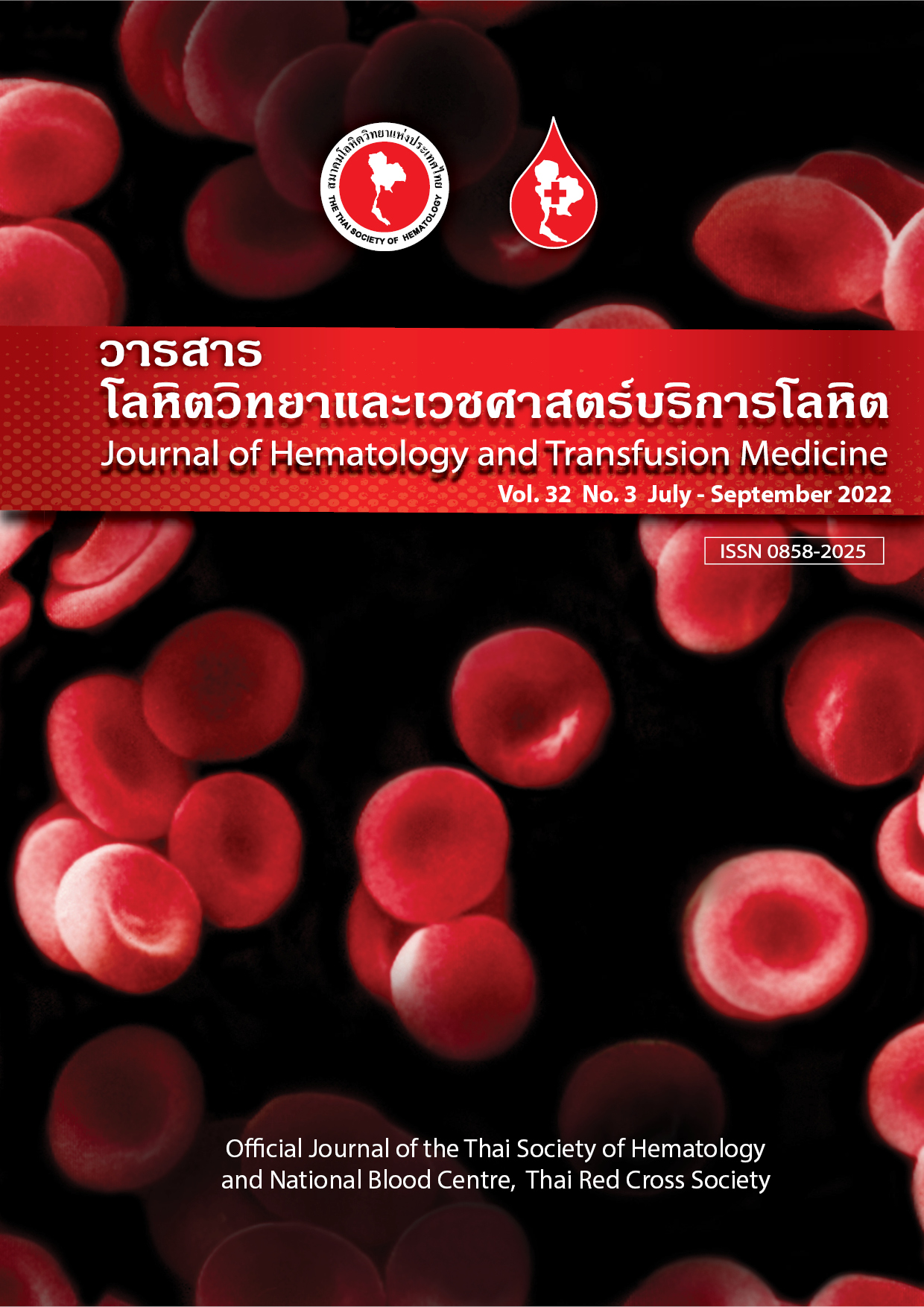Comparing Quality of Life of Prophylaxis versus on Demand Treatment among Patients with Hemophilia at Siriraj Hospital
Keywords:
Hemophilia, Quality of life, Low dose prophylaxis, Target joint, ThailandAbstract
Introduction: Hemophilia is an X-linked recessive bleeding disorder. Standard treatment for severe hemophilia constitutes factor concentrate prophylaxis treatment. Due to government budget control in Thailand, prophylaxis with a standard dosage factor remains limited. This study examines quality of life of patients with hemophilia on low dose prophylaxis protocol versus on-demand treatment. Objective: The study aimed to compare quality of life of patients with hemophilia on low dose prophylaxis versus on-demand treatment and the factors affecting quality of life among patients with hemophilia. Methods: Question-based research was conducted using Haemo-QOL kids and Haemo-A-QOL among patients with moderate to severe hemophilia aged 8-25 years old at the Department of Pediatrics, Faculty of Medicine, Siriraj Hospital, Mahidol University between September 2019 and November 2020. Results: Thirty-three patients with hemophilia were enrolled in the study; 23 patients were in the age group 8-16 years, and 10 patients were in the age group 16-25 years. Sixteen patients were treated by on-demand protocol and 17 patients were treated by low dose prophylaxis protocol. Quality of life of patients with severe hemophilia aged 8-16 years with low dose prophylaxis protocol was better than those with on-demand treatment (p-value = 0.036) especially regarding physical, family, sport/leisure and treatment domains. Furthermore, factors affecting quality of life in the age group 16-25 years were travel time from home to hospital (p-value =0.01) and target joints (p-value = 0.05). Conclusion: The quality of life of patients with severe hemophilia aged 8-16 years with low dose prophylaxis protocol was significantly better than those with on-demand treatment.
Downloads
References
Srivastava A, Brewer AK, Mauser-Bunschoten EP, Key NS, Kitchen S, Llinas A, et al. Guidelines for the management of hemophilia. Haemophilia. 2013;19:e1-47.
Stonebraker JS, Bolton-Maggs PHB, Brooker M, Evatt B, Iorio A, Makris M, et al. The World Federation of Hemophilia Annual Global Survey 1999-2018. Haemophilia. 2020;26:591-600.
Gringeri A, Lundin B, von Mackensen S, Mantovani L, Mannucci PM, Group ES. A randomized clinical trial of prophylaxis in children with hemophilia A (the ESPRIT Study). J Thromb Haemost. 2011;9:700-10.
Manco-Johnson MJ, Abshire TC, Shapiro AD, Riske B, Hacker MR, Kilcoyne R, et al. Prophylaxis versus episodic treatment to prevent joint disease in boys with severe hemophilia. N Engl J Med. 2007; 357:535-44.
Wu R, Sun J, Xiao J, Liu Y, Xue F, Wang H, et al. A prospective study of health-related quality of life of boys with severe haemophilia A in China: comparing on-demand to prophylaxis treatment. Haemophilia. 2017; 23:430-6.
Feldman BM, Pai M, Rivard GE, Israels S, Poon MC, Demers C, et al. Tailored prophylaxis in severe hemophilia A: interim results from the first 5 years of the Canadian Hemophilia Primary Prophylaxis Study. J Thromb Haemost. 2006;4:1228-36.
Windyga J. Is Continuous Low-Dose Prophylaxis Superior to On-Demand Treatment for Patients with Hemophilia? Semin Thromb Hemost. 2016;42:533-40.
Tang L, Wu R, Sun J, Zhang X, Feng X, Zhang X, et al. Short-term low-dose secondary prophylaxis for severe/moderate haemophilia A children is beneficial to reduce bleed and improve daily activity, but there are obstacle in its execution: a multi-centre pilot study in China. Haemophilia. 2013;19:27-34.
Mulder K, Llinas A. The target joint. Haemophilia. 2004;10(Suppl 4):152-6.
Li H, Sun J, Zhou X, Liu Y, Song X, Ma Q. [Clinical predictors for the phenotypic heterogeneity of severe hemophilia A in China]. Nan Fang Yi Ke Da Xue Xue Bao. 2013;33:424-7.
Zhang H, Huang J, Kong X, Ma G, Fang Y. Health-related quality of life in children with haemophilia in China: a 4-year follow-up prospective cohort study. Health Qual Life outcomes. 2019;17:28.
Royal S, Schramm W, Berntorp E, Giangrande P, Gringeri A, Ludlam C, et al. Quality-of-life differences between prophylactic and on-demand factor replacement therapy in European haemophilia patients. Haemophilia. 2002;8:44-50.
O’Hara J, Walsh S, Camp C, Mazza G, Carroll L, Hoxer C, et al. The impact of severe haemophilia and the presence of target joints on health-related quality-of-life. Health Qual Life Outcomes. 2018;16:84.
Downloads
Published
Issue
Section
License
Copyright (c) 2022 Journal of Hematology and Transfusion Medicine

This work is licensed under a Creative Commons Attribution-NonCommercial-NoDerivatives 4.0 International License.



